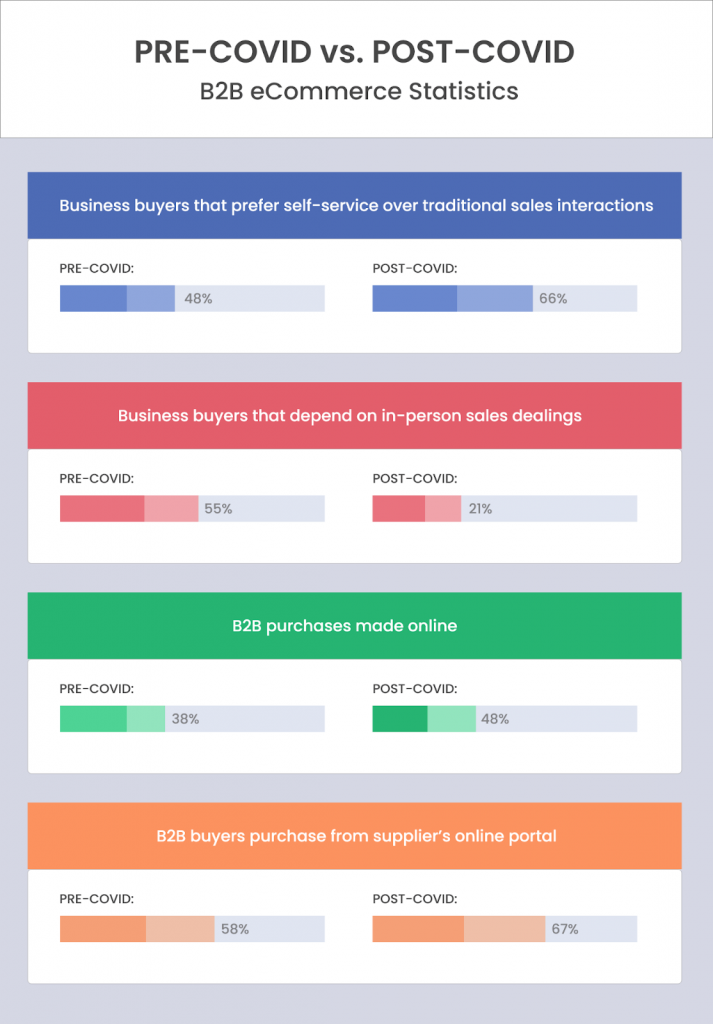“Luck is what happens when preparation meets opportunity.”
It’s been almost a decade since we started talking about the changing landscape of B2B commerce and the new millennial mindset of business buyers who are demanding consumer-like experiences they enjoy on sites like Amazon.
While most researchers had already predicted massive growth in B2B eCommerce, none of them knew just how pivotal 2020 would be.
When the world began to drop its shutters, and physical spaces and supply chains were disrupted, only one channel remained open: eCommerce. And people who had already invested in an eCommerce strategy were able to seize the opportunity and experience growth. In other words, they created their own luck.
B2B eCommerce and Covid
Let’s take a look at how the global pandemic has stepped on the growth of B2B eCommerce.

With the industry gearing towards B2B eCommerce, the challenge now is to deliver a seamless, self-service experience your buyers need to do business with you.
The question is, are you prepared to seize the opportunities?
Jump onto the B2B eCommerce Bandwagon – if you haven’t done already
If your customers have to call your sales reps for pricing and inventory details, your business falls in the category of “too hard to buy from”, which means you’re missing out on all the eCommerce opportunities this changing landscape is throwing at you.
And so, it’s high time to step up and create a digital strategy that enables you to deliver a seamless and intuitive experience buying from a self-service web portal.
However, before you get your online store up and running, it’s better to consult a B2B eCommerce agency for creating a digital strategy and also determining how aggressively digital you want to be.
Identify the Friction Points in your Buyer’s Journey

If you already have an online B2B store, the next step is to identify the points that cause friction in your buyer’s journey so you can fix those and deliver a smooth and straightforward experience for your buyers.
Use site analytics to map the customer’s journey
Using analytics tools like Google Analytics and Hotjar will help you identify the points that are causing friction for the buyer and making him fall out of the buying flow. Measuring KPIs like conversion rate, bounce rate, and cart abandonment can help you identify the areas that need to be streamlined for a seamless buying experience.
Take feedback from customers to understand their pain points

Is there any better way to figure out the customer’s pain points than asking the customers themselves? Send them survey-emails or just call them and ask about their purchasing experience and what matters the most when they are buying online.
Use live chat solutions to talk to customers and listen to them
Implement a live chat solution on your store so your customers can easily reach out to your customer service reps and express their concerns and offer suggestions about their online experience. Use those chat conversations to extract insights about what problems the customer is facing when purchasing online.
Streamline Your Customer’s Buying Experience
Once you’ve identified the problem areas, the next step is to fix them and remove friction to streamline your customers’ buying process.
Here are some ways you can do that.
Implement a Request for Quote feature

Pricing is rarely straightforward in the B2B industry, and it mostly depends on a range of factors like custom product requirements, quantity ordered, and the relationship with the customer.
A quotation functionality can streamline the buying process by offering a form solution embedded on the product page. The buyer sends his requirements and bids his price, which is routed to the sales team through email. The sales team responds and offers a custom price quotation, which is sent through checkout and order processing on approval by the customer.
Check out this B2B eCommerce plugin for WooCommerce stores that allows you to add quotation functionality, among many other wholesale specific features to your online store.
Offer a catalog with rich content
Returning customers won’t have much problem when placing orders with limited product data. But a new customer who has landed on your site during the research phase will need detailed product information to help in their buying decision.
Make sure you go the extra mile when designing your product pages. Include rich product information including downloadable PDFs, product images, and other media that makes it easy for the customer to make a buying decision.
Make it easy for them to buy from you
When customers land on your B2B online store, they don’t want to go through an extensive catalog of hundreds or thousands of products trying to find what they need. Remove the friction from this process by making it easy for them to find what they need with intuitive search functionalities.
Bulk order forms that allow customers to place an order through SKUs and CSV upload will help your returning customers place an order without going through your product catalog.
Product tables with powerful search and filters will also help the customer search and buy from a single page without navigating through different product pages.
Another thing that can streamline the customer’s buying experience is by offering a custom catalog tailored for the customer visiting the site. This can be done by controlling the visibility of your product catalogs based on the customer’s data. So, if someone from a certain country is visiting your site, you can hide or show only the products you think that customers would be interested in instead of displaying all the products you have.
Personalize Your Customer’s journey with real-time data
To really personalize your customer’s journey, it’s important to have real-time data about your inventory, products, and the relationship with the customer. This can be done through integrations of different systems with your eCommerce platform so that all your business systems like ERP, PIM, CRM, etc. are synced with each other and provide accurate data that enhances the customer’s experience.
Offer real-time account and order status
Your customers want to self-serve their own accounts so they can see their order and credit status in real-time. They also want to have the ability to add their team members in their accounts and give them tiered permissions so they can create their procurement workflows.
With the right technology like b2BWoo (WooCommerce B2B), you can create a complete 360-degree eCommerce experience where your buyers can smoothly search for products and find what they need, place orders intuitively, view their account status, and deliver a straightforward experience they deserve.
Read Also
